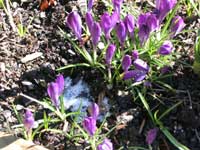 |
Common crocus is the best known and most widely grown of the many types of crocuses. It and its hybrids, sometimes called Dutch crocus, are larger and bloom slightly later than their wild cousins. Related to irises, crocuses grow from a modified bulb called a corm. Their jaunty emergence in lawns and gardens signals the waning of winter. While all types of crocus are a favorite of squirrels, common crocus is less bothered than the earlier flowering ones. Common crocuses are favorites for forcing indoors as well.
Crocuses, like most bulbs, require very little care. If they are planted in the lawn, be prepared to leave the area unmown until the crocus foliage has died. Once planted, they can remain in the ground undisturbed for years. Common crocus can be grown as far north as northern New York, coastal New England and up to the Great Lakes (Zone 4). They are hardy where it seldom gets colder than -10 to -20°F.
Size: Common crocuses are usually 3 to 6 inches tall, their Dutch hybrids reaching 8 inches. They are narrow, upright little plants, at most 2 inches wide.
Foliage: Crocus leaves emerge directly from the soil, initially in a tight bundle. Typically two to four to a plant, the leaves are narrow and grasslike. They are dark green; and some also have a silvery mid stripe. They emerge and spread apart at the same time the flowers emerge. Eventually they grow from 4 to 6 inches long before withering and dying back.
Flower: Crocus flowers are 2 to 5 inches long, bell or funnel-shaped, arising directly from the corm or from a very short stalk in bunches of up to 6 flowers per corm. They bloom in late February or early March. Those planted near a building in a sunny sheltered area may flower two weeks earlier. Flower colors range through white, yellow, blue and lavender to purple. Many kinds are bicolor or streaked in the throat. Some other types (such as Crocus chrysanthus) are scented. The flowers last about 10 days.

